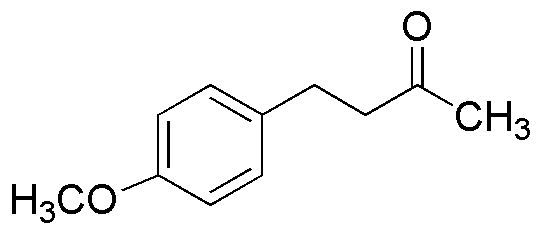4-(4-Methoxyphenyl)-2-butanone is widely utilized in research focused on:
- Fragrance Industry: This compound is often used as a key ingredient in perfumes and scented products, providing a pleasant aroma that enhances consumer appeal.
- Flavoring Agents: It serves as a flavoring agent in food products, contributing to the taste profile of various items, particularly in confectionery and baked goods.
- Pharmaceuticals: The compound is explored for its potential therapeutic properties, making it a candidate for drug formulation in medicinal chemistry.
- Cosmetics: It is incorporated into cosmetic formulations, where it acts as a fragrance component, improving the sensory experience of skincare and beauty products.
- Research and Development: Researchers utilize this compound in studies related to organic synthesis and material science, exploring its chemical properties and potential applications in new technologies.
Informations générales
Propriétés
Sécurité et réglementation
Applications
4-(4-Methoxyphenyl)-2-butanone is widely utilized in research focused on:
- Fragrance Industry: This compound is often used as a key ingredient in perfumes and scented products, providing a pleasant aroma that enhances consumer appeal.
- Flavoring Agents: It serves as a flavoring agent in food products, contributing to the taste profile of various items, particularly in confectionery and baked goods.
- Pharmaceuticals: The compound is explored for its potential therapeutic properties, making it a candidate for drug formulation in medicinal chemistry.
- Cosmetics: It is incorporated into cosmetic formulations, where it acts as a fragrance component, improving the sensory experience of skincare and beauty products.
- Research and Development: Researchers utilize this compound in studies related to organic synthesis and material science, exploring its chemical properties and potential applications in new technologies.
Documents
Fiches de données de sécurité (FDS)
La FDS fournit des informations de sécurité complètes sur la manipulation, le stockage et l’élimination du produit.
Spécifications du produit (PS)
Le PS fournit une description complète des propriétés du produit, notamment sa composition chimique, son état physique, sa pureté et les exigences de stockage. Il détaille également les plages de qualité acceptables et les applications prévues du produit.
Certificats d'analyse (COA)
Recherchez des certificats d'analyse (COA) en saisissant le numéro de lot du produit. Les numéros de lot et de lot se trouvent sur l'étiquette d'un produit, après les mots « Lot » ou « Lot de fabrication ».
Numéro de catalogue
Numéro de lot/série
Certificats d'origine (COO)
Ce certificat d'exploitation confirme le pays dans lequel le produit a été fabriqué, et détaille également les matériaux et composants utilisés et s'il est issu de sources naturelles, synthétiques ou autres sources spécifiques. Ce certificat peut être requis pour les douanes, le commerce et la conformité réglementaire.
Numéro de catalogue
Numéro de lot/série
Fiches de données de sécurité (FDS)
La FDS fournit des informations de sécurité complètes sur la manipulation, le stockage et l’élimination du produit.
DownloadSpécifications du produit (PS)
Le PS fournit une description complète des propriétés du produit, notamment sa composition chimique, son état physique, sa pureté et les exigences de stockage. Il détaille également les plages de qualité acceptables et les applications prévues du produit.
DownloadCertificats d'analyse (COA)
Recherchez des certificats d'analyse (COA) en saisissant le numéro de lot du produit. Les numéros de lot et de lot se trouvent sur l'étiquette d'un produit, après les mots « Lot » ou « Lot de fabrication ».
Numéro de catalogue
Numéro de lot/série
Certificats d'origine (COO)
Ce certificat d'exploitation confirme le pays dans lequel le produit a été fabriqué, et détaille également les matériaux et composants utilisés et s'il est issu de sources naturelles, synthétiques ou autres sources spécifiques. Ce certificat peut être requis pour les douanes, le commerce et la conformité réglementaire.

